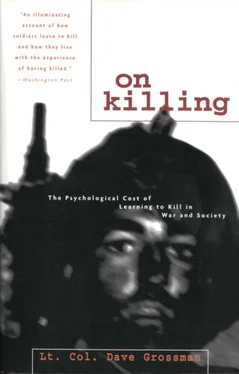Gabriel discards the gain-through-illness explanation in the case of prisoners of war (POWs) and guards receiving artillery fire or bombardment. He comes much closer to a more plausible explanation when he states that the prisoners “had shifted responsibility for their survival to the guards.” The prisoners had indeed relinquished responsibility to their guards: responsibility for survival and responsibility for killing.
The prisoners were unarmed, impotent, and strangely at peace with their lot in life. They had no personal capacity or responsibility to kill, and they had no reason to believe that the incoming artillery or bombs were a personal matter. The guards, on the other hand, took the matter as a personal affront. They still had a capacity and a responsibility to fight, and they were faced with the irrefutable evidence that someone was intent on killing them and that they had a responsibility to do likewise. The psychiatric casualties among the guards — as among most other soldiers in the same circumstances — represented an accepted method of escape from the unbearable responsibility inherent in their roles as soldiers.
Fear and Sailors in Naval Combat
For thousands of years naval battles involved missile combat (bow and arrows, ballista, cannons, and so on) at extremely close range, followed by grappling, boarding, and vicious life-or-death, close-in battle with no way to escape. The history of such naval warfare — like that of ground combat — provides many examples of psychiatric casualties resulting from this kind of combat. In its emotional demands naval warfare was very much like its landbased equivalent.
But in the twentieth century, psychiatric casualties during naval warfare have been nearly nonexistent. The great military physician Lord Moran noted the remarkable absence of psychological illness among the men he ministered to aboard ships in World War II. Discussing his experience in two ships, he said, “One was sunk after surviving more than two hundred raids and the whole of the first Libyan campaign. The other was in four major actions in addition to many raids at sea and in harbour, and twice sustained actual damage.” Yet the incidence of psychiatric casualties was almost nonexistent. “There were more than five hundred men in the two ships and of these only two came to me about their nerves.”
After World War II the fields of psychiatry and psychology attempted to find out why, and again they suggested gain through illness. The sailor obviously had nothing to gain by becoming a psychiatric casualty and therefore did not elect to do so.
The idea that modern sailors had nothing to gain through becoming a psychiatric casualty is simply absurd. The sick bay of a warship is traditionally placed in the safest and most secure heart of the ship. A sailor standing in the open, firing a deck gun at an attacking aircraft, has much to gain by making for the relative safety of sick bay. And even if his psychiatric symptoms can’t get him completely away from this battle, they can most assuredly get him away from future ones.
So why don’t these sailors suffer from the same psychiatric ailments that their brothers on land do? Modern sailors suffer and burn and die just as horribly as their land-bound equivalents. Death and destruction fall all about them. Yet they do not crack. Why?
The answer is that most of them don’t have to kill anyone directly, and no one is trying to specifically, personally, kill them.
Dyer observes that there has never been a similar resistance to killing among artillerymen or bomber crews or naval personnel. “Partly,” he says, this is due to “the same pressure that keeps machine-gun crews firing, but even more important is the intervention of distance and machinery between them and the enemy.” They can simply “pretend they are not killing human beings.”
Instead of killing people up close and personal, modern navies kill ships and airplanes. Of course there are people in these ships and airplanes, but psychological and mechanical distances protect the modem sailor. World War I and World War II ships often fired their weapons at enemy ships that could not be seen with the naked eye, and the aircraft they fired at were seldom more than specks in the sky. Intellectually these naval warriors understood that they were killing humans just like themselves and that someone wanted to kill them, but emotionally they could deny it.
A similar phenomenon has occurred in aerial combat. As previously noted, World War I and World War II pilots, in relatively slow-moving aircraft, could see enemy pilots, and thus large numbers of them failed to fight aggressively. Desert Storm pilots, fighting an enemy seen only on a radar scope, had no such problems.
Fear and Patrols Behind Enemy Lines
Another circumstance that is free of the usual psychiatric casualties associated with the battlefield involves patrols behind enemy lines. Although highly dangerous, such patrols are by their very nature a different kind of combat, and in wars throughout this century they have had some common characteristics.
As an infantry company commander and an army Ranger, I have been trained by the U.S. Army to plan and conduct such patrols and have done so in training on many occasions. The majority of patrols are usually reconnaissance patrols. On a recon patrol a small, lightly armed body of men is sent into enemy territory with specific orders not to engage the enemy. Their mission is to spy on the enemy, and if a recon patrol runs into an enemy force it will immediately break contact with the enemy. The essence of a recon patrol is not to be found or seen, and there is not enough firepower with such a patrol to support any kind of offensive operation.
Thus, although recon patrols are dangerous, and the information produced may result in many enemy soldiers being killed, the mission itself is a very benign operation. It is an operation completely free of any obligation or intention to directly confront or kill the enemy. Sometimes there is a requirement to capture a prisoner, but even this is a relatively limited engagement with the enemy. What could be psychologically less traumatic than being ordered to run from enemy aggression?
If a patrol is not a recon patrol, it is usually on an ambush or a raid, in which a select group of men will attack the enemy at a planned point. Just as in a recon patrol, a combat patrol will immediately break contact with the enemy if it is spotted while moving to or from its objective. The killing actions of a raid or ambush are focused on one particular spot for one brief period of time; at all other times the patrol, which depends on surprise for its success, will run from the enemy.
A raid or ambush patrol is carefully and thoroughly planned and rehearsed prior to leaving friendly lines, and the time in which killing takes place will be extremely brief, and very much like that practiced in rehearsal. The psychologically protective power of (1) hitting a precise, known objective and of (2) conducting such exact rehearsals and visualizations prior to combat (a form of conditioning) is tremendous. Thus, by their very nature, such combat patrols involve far less random killing and are therefore less conducive to psychiatric casualties.
An additional factor to consider here is — as Dyer points out — that the extremely rare “natural soldiers” who are most capable of killing (those identified by Swank and Marchand as the 2 percent predisposed toward aggressive psychopathic tendencies) can be found “mostly congregating in the commando-type special forces [units].” And it is just such units as these that are usually given the mission of conducting combat patrols behind enemy lines.
Читать дальше







